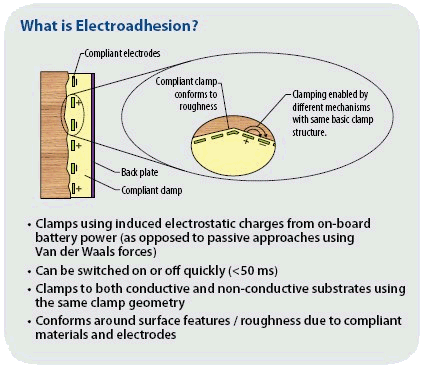Events such as natural disasters, military actions, and public safety threats have led to an increased need for robust robots — especially ones that can travel across complex terrain in any dimension. The ability to scale vertical building surfaces or other structures offers unique capabilities in military applications such as urban reconnaissance, sensor deployment, and setting up urban network nodes. SRI's novel clamping technology, called compliant electroadhesion, has enabled the first application of this technology to wall-climbing robots that can help with these situations.
As the name implies, electroadhesion is an electrically controllable adhesion technology. It involves inducing electrostatic charges on a wall substrate using a power supply connected to compliant pads situated on the moving robot. SRI has demonstrated robust clamping to common building materials including glass, wood, metal, concrete, etc. with clamping pressures in the range of 0.5 to 1.5 N per square cm of clamp (0.8 to 2.3 pounds per square inch). The technology works on conductive and non-conductive substrates, smooth or rough materials, and through dust and debris. Unlike conventional adhesives or dry adhesives, the electroadhesion can be modulated or turned off for mobility or cleaning. The technology uses a very small amount of power (on the order of 20 microwatts/Newton weight held) and shows the ability to repeatably clamp to wall substrates that are heavily covered in dust or other debris.
Electroadhesive robots have demonstrated excellent adhesion on a wide variety of materials with climbing speeds of up to 1 body length (25cm) per second.
Electroadhesion offers advantages over other types of technologies for wall climbing, including robust clamping over a variety of surfaces (rough or smooth, conductive or insulating), low power, resistance to dust, and fast, electrically controllable clamping and unclamping. Thus, electroadhesion lends itself to a variety of wall-climbing robots. Tracked "tank" type wall-climbing robots, as well as more biomimetic inchworm-type robots, have been successfully demonstrated to date using this technology. Other advantages of electroadhesion include its non-damaging nature, and lightweight, which is crucial in wall-climbing applications.
While current wall-climbing robots have been operated via remote control, in the future, we anticipate that they will be able to operate beyond line of sight, at customizable range, or using a GPS receiver. Pads are scalable to different dimensions. Speed, payload, surface requirements, directional preferences are customizable for specific mission requirements.Wide-Ranging Applications
- Wall-climbing robots for military and first responders: Real-time and/or longer-term reconnaissance of buildings
- Inspection Robots: For military or commercial applications such as inspection of bridges, containers, pipes and storage tanks, buildings, structural walls, ducts, aircraft and ship hulls and communications and transmission lines and towers
- Service Robots: For cleaning (windows, building walls etc.), painting (buildings, bridges, aircraft etc.) and other such needs
- Sensor positioning and re-positioning: For mobile sensors that can be repositioned in three dimensions (for example, in self-organizing networks)
- Toys/hobby robots
- Long-term perching of micro air vehicles (MAVs): In many cases, aerial mobility can be leveraged in conjunction with longer-term perching on a vertical wall
- In the future: human wall climbing: For uses ranging from Special Forces needs to exterior window-cleaning
- Other applications that require three-dimensional mobility
This patent-pending technology is available for license. - sri
The back up Blog of the real Xenophilius Lovegood, a slightly mad scientist.
Thursday, June 5, 2008
Electroadhesive Robots
Subscribe to:
Post Comments (Atom)

No comments:
Post a Comment